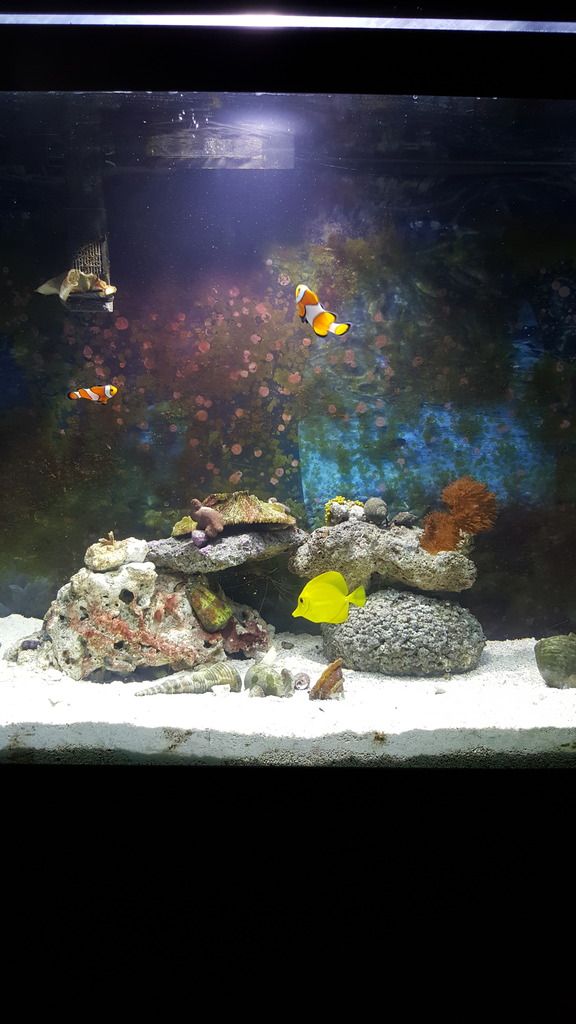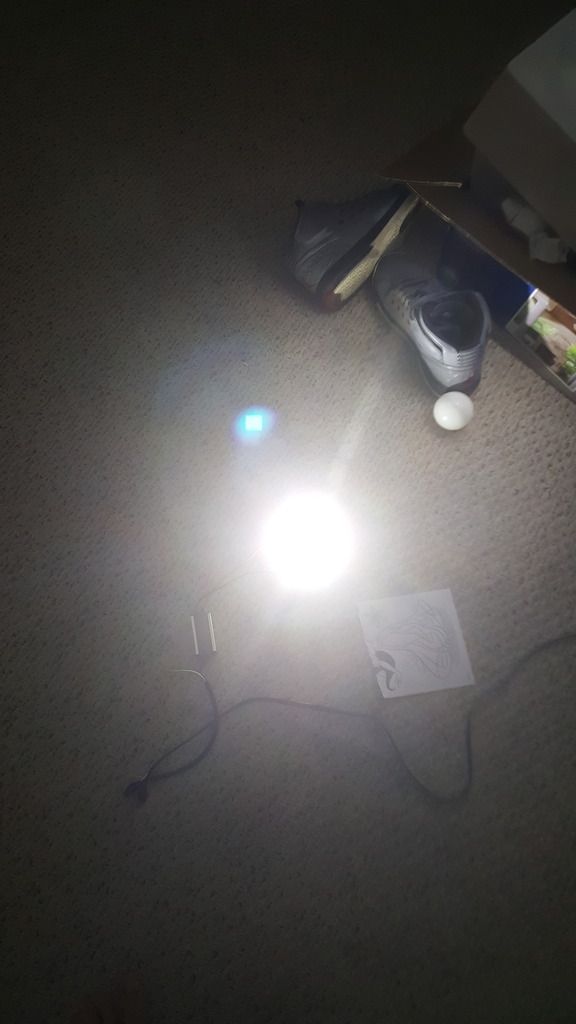


|
 |
|
|
#1 |
|
Registered Member
Join Date: Jul 2016
Location: Cambridge, OH
Posts: 311
|
Too much light?
I am doing a DIY LED light, I am starting a reef tank. I have been given a few soft corals from a friend who was re-doing his layout as well as one sps frag (hydnophora).
Right now I have ordered a 30W 6000k LED chip. I wired it today and it is wayyyy brighter than I thought it would be. I haven't hung it yet, I am still waiting on heatsink and lens. I also have on order 10 x 3W 455nm Blue LEDs. And one 100W 455nm blue LED chip. After being blinded by looking straight into the 30W, I am afraid I have overdone it with the 100W blue. Grand total 130W in blue, and 30 of white. Before seeing this 30W today I thought I was going to order a couple 3W whites to offset the possibly very blue tone. I am brand as this is my first tank. 55 gal. 21" Tall. I plan on getting a large variety of corals sps, lps, soft, whatever looks good and lives good together. Is this too much light. Should I cancel the 100W blue and order a lesser version, or will I need all of it and more? Or am I just fine and maybe hang it a little higher? Please be easy on me lolz. PS. this is a picture of the light for the few moments I had it on without the heat sink.  
|
|
|

|
|
|
#2 |
|
Registered Member
Join Date: Aug 2009
Location: DuPont, WA
Posts: 947
|
That is a lot of light. The problem is also the focused beam. Most modern LED fixtures have around 120 degree spread, that one you have is like a laser beam! I'm not really an authority but some guys on hear like Ron Reefman and others know a lot about LED's. I would suggest looking at the lighting thread here, lot's of good stuff. Hopefully an LED expert will chime in.
__________________
Even a Blind Squirrel finds a Nut now and then. Current Tank Info: 6.25 gal Nano, 40 gal SPS |
|
|

|
|
|
#3 |
|
Saltwater Addict
Join Date: Jan 2012
Location: Vandalia OHIO
Posts: 11,624
|
You need to take par readings in the tank to figure out how much of that light is making it to the sandbed ect. Looks bright and very focused, only way to know is with a par meter
__________________
Fish are not disposable commodities, but a worthwhile investment that can be maintained and enjoyed for many years, providing one is willing to take the time to understand their requirements and needs Current Tank Info: 625g, 220g sump, RD3 230w, Vectra L1 on a closed loop, 3 MP60s, MP40. Several QTs |
|
|

|
|
|
#4 | |
|
Registered Member
Join Date: Apr 2015
Location: Huntington, NY
Posts: 391
|
Quote:
+1. Your eyes are not a good measure of how much and what spectrum of light your corals will need. Also, unlike metal halides and t5 things like watts etc don't necessarily translate into PAR for LEDS. Some reef clubs have PAR meters for club members to share. You may be able to rent one. BRS tested the SENEYE REEF MONITOR PAR meter against a high end PAR meter that works with LEDS and the numbers were very close, at $199 it's one of the most affordable, reliable. |
|
|
|

|
|
|
#5 |
|
Registered Member
Join Date: Sep 2003
Location: North Carolina
Posts: 20,050
|
Hopefully you were smart and went with a dimmable driver..
If not.. get smart now  A good "starting point" for LED lit tanks is the following formula Where L = length of tank in inches W = width of tank in inches For medium light corals. Watts = ((L * W)/22)*3 For SPS (high light corals) Watts = ((L * W)/18)*3 So an example 55G (48L x 13W) Watts = ((48 * 13)/22)*3 = 85 Watts (medium light) or 104 watts (high light)
__________________
Who me? |
|
|

|
|
|
#6 |
|
Registered Member
Join Date: Jul 2016
Location: Cambridge, OH
Posts: 311
|
McGyver Didn't get the dimmable driver on this one, because the driver came with it, and the light and driver were only $8 together. I figured worst case scenario I have just run an $8 experiment.
NeilFox, I have a lens on the way. It won't be a laser beam for long. How much are reefclub memberships? I am on a DIY budget at the time being so $199 par meter could be better spent on a hundred different things for me. I don't have a sump or skimmer yet. It's basically fowlr for now plus the free corals I've inherited. NS Mike D, I've heard current is a better rating on the output of LED's than wattage. This is 900mA. In general, I am trying to get a gauge on if I am in the right ballpark at all for the moment. I understand I am months and months and months from buying corals. I have a lot of building to do before I move away from these free softies. But I wan't to have all of the equipment established before I start fine tuning with par meters. I'm just wondering if this is an insane amount of light? |
|
|

|
|
|
#7 |
|
Registered Member
Join Date: Apr 2015
Location: Huntington, NY
Posts: 391
|
The LIRA (long island) membership is $25 per year. Can't speak for other clubs, but things are generally more expensive here.
Wattage, I am not an expert doI can't opine on 900mA. I suspect that is a better indication. My knowledge is limited to knowing that the efficiency of LEDS various a lot, so that wattage doesn't translate the same way for the other types of lights. As for the blue spectrum, the manufacturer of my LEDS uses four sets of blues; 400, 420, 440, and 460nm. When you decided to add corals, do more research into the blue spectrum as well as the red and green. You can always swap or add LEDS inexpensively if you decide you want more spectrums in the blend. Seems you have a lot of time before you will need to get more precise confirmation of the PAR levels in you tank. Given how much we spend on corals. it just makes common sense to take the guess work out of PAR to protect our investments (expensive corals). Note related to mcgyver posted formulas; I didn't run the numbers, but as another reference, BRS just did a review of AI HD lights and for a 24 gal cube tank, the fixture was using 50 total watts, fwiw. |
|
|

|
|
|
#8 |
|
Registered Member
Join Date: Jul 2016
Location: Cambridge, OH
Posts: 311
|
Do the clubs have to be local? Or are they online clubs?
I do plan to get into more wavelengths. Finding manufacturers that supply wavelength specific lights affordably is the tricky part. I want almost exactly the four wavelengths you described. As well as enough high K white to make it seem not so dark and blue (on demand only not all the time). I plan on controlling all these with a rasberrypi computer, and some relays, or a clickPLC. Such that I can manipulate intensity, duration, and emulate sunrises, sunsets, and storms. I'm an engineer, so I can't bring myself to spend almost a thousand dollars on something I can build and program for less than $200. My plan for the light is to have lots of options in color available. But the main set will be what we are talking about, (fine tuned for PAR), then I will have the controller set to a set percent chance of cloudy days, stormy days etc. limiting one storm per week or less. Just to mix things up. Then I can do a mobile app to control all cool effects. What are your thoughts on red and green? Everything I have heard seems like they aren't needed. Almost undesirable. I know the peaks of the blue/purple spectrum are the most needed, or at least most used. |
|
|

|
|
|
#9 | |
|
Registered Member
 Join Date: Jul 2010
Location: Austin, TX
Posts: 1,985
|
Quote:
__________________
"Our crystal clear aquaria come nowhere close to the nutrient loads that swirl around natural reefs" Charles Delbeek |
|
|
|

|
|
|
#10 |
|
Registered Member
Join Date: Jul 2016
Location: Cambridge, OH
Posts: 311
|
@Timfish can you elaborate a little more? I assume you're saying I have too much blue? what ratio would you suggest?
|
|
|

|
 |
|
|